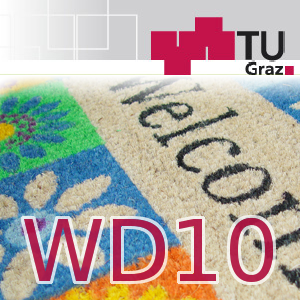Nach Prof. Narayanan Kulathuramaiyer zum Thema Mashup, Prof. Niemeier zu Social Media, Martin Raske zu e-Learning in Unternehmen und Heimo Sandtner zu 3D-Simulationen folgt das fünfte Interview im Zuge des L3T-Projektes. Diesesmal teilt uns Mandy Schiefner ihre Meinung zu „Medienkompetenz“ mit. Auch diesesmal ein Dank für die interessanten Aussagen:
Broschüre über die Serviceangebote

Der Zentrale Informatikdienst der TU Graz bringt soeben eine neue Broschüre [.pdf] heraus, wo alle Services übersichtlich dargestellt werden:
Der Zentrale Informatikdienst (ZID) ist Ihr IT-Dienstleister der TU Graz und stellt Ihnen die IT- und Medieninfrastruktur, die im Rahmen von Lehre, Forschung und Verwaltung erforderlich ist, zur Verfügung. Um Ihnen das Lernen, Lehren und Forschen an der TU Graz zu erleichtern, bieten wir eine Vielzahl von EDV- und Medien-Diensten an, die laufend erweitert und verbessert werden.
Wir hoffen damit einen kleinen Beitrag geleistet zu haben, die Supportleistungen zu erweitern.
[presentation] @twitter Mining #Microblogs Using #Semantic Technologies
Our presentation on “@twitter Mining#Microblogs Using #Semantic Technologies” at this year 6th Workshop on Semantic Web Applications and Perspectivesis now online available.
The publication has already been published here.
[iTunesU] Welcome Days 2010
 Die Aufzeichnungen der Welcome Days 2010 sind ab sofort in iTunesU der TU Graz verfügbar. Damit können alle einleitenden Vorträge nachgehört werden und wir hoffen, dass damit Unklarheiten schneller beseitigt werden können.
Die Aufzeichnungen der Welcome Days 2010 sind ab sofort in iTunesU der TU Graz verfügbar. Damit können alle einleitenden Vorträge nachgehört werden und wir hoffen, dass damit Unklarheiten schneller beseitigt werden können.
Allen unseren Studienanfänger/innen nochmals alles Gute für ihr Studium und viel Spaß an der TU Graz.
[l3t] Heimo Sandtner – 3D-Simulationen
Nach Prof. Narayanan Kulathuramaiyer zum Thema Mashup, Prof. Niemeier zu Social Media und Martin Raske zu e-Learning in Unternehmen folgt das vierte Interview im Zuge des L3T-Projektes. Diesesmal antwortet Heimo Sandtner zu „3D-Simulationen für e-Learning„. Auch diesesmal ein Dank für die interessanten Aussagen:
[article] Vier Jahre TeachCenter – eine Lernplattform etabliert sich
In der neuen internen Zeitschrift der TU Graz TU Graz people, ist eine kurzer Artikel über unsere Aktivitäten erschienen:
[publication] @twitter Mining#Microblogs Using #Semantic Technologies
Our publication on „@twitter Mining#Microblogs Using #Semantic Technologies“ at this year 6th Workshop on Semantic Web Applications and Perspectives is now online available.
Abstract:
In this paper we report about our current and ongoing research efforts aiming at knowledge discovery, offline social data mining and social entity extraction based upon semantic technologies. Further we are aiming to provide the scientific architecture paradigm for building semantic applications that rely on social data. In this early stage our work focuses on data from Twitter as currently most popular and fastest growing microblogging platform. In the realm of our research we implemented applications like Grabeeter for storing searching and caching the social data and STAT infrastructure that uses semantic standards like RDF (SIOC, FOAF), SPARQL and existing semantic services as Sinidice and Linked Data silos as DBPedia or GeoNames as well. They represent parts of novel architecture paradigm for semantic social applications intended to be introduced here.
Reference: Softic, S.; Ebner, M.; Mühlburger, H.; Altmann, T.; Taraghi, B., (2010) @twitter Mining #Microblogs Using #Semantic Technologies, in: 6th Workshop on Semantic Web Applications and Perspectives (SWAP 2010), p. 1 – 12, https://www.inf.unibz.it/krdb/events/swap2010/page10/page10.html (last access Oct. 2010)
[fnma] 20. Tagung des Vereins Forum neue Medien Austria
 In meiner Rolle als Vizepräsident des Vereins Forum neue Medien Austria freut es mich die 20. Tagung anzukündigen, welche den Titel „Hochschullehre im Jahre 2020“ trägt. Stattfinden wird sie an der
In meiner Rolle als Vizepräsident des Vereins Forum neue Medien Austria freut es mich die 20. Tagung anzukündigen, welche den Titel „Hochschullehre im Jahre 2020“ trägt. Stattfinden wird sie an der
Höhere Graphische Bundes-Lehr- und Versuchsanstalt in Wien „die Graphische“.
Besonders freut es uns, dass es uns gelungen ist auch einen Call for Participation zu erstellen, wo die Bildung von Arbeitsgruppen zu hochschulübergreifenden Themen ermöglicht werden soll:
Das Forum neue Medien Austria (fnm-austria) schreibt hiermit drei einjährige Leitungen von drei Arbeitsgruppen zu den Schwerpunktthemen „Qualität der Hochschullehre“, „Austausch von hochschuldidaktischen Modellen“ und „Technologiegestützte Lehrinnovation“ aus. Einreichungen können bis spätestens 17. Oktober 2010 erfolgen, wobei alle Mitglieder des Forum neue Medien Austria einreichberechtigt sind. Der Call wendet sich an Personen, die die Koordination der Arbeitsgruppenmitglieder sowie die Zusammenfassung der Ergebnisse übernehmen wollen. Pro Arbeitsgruppenleitung stehen eine Aufwandsentschädigung in der Höhe von 3.000 Euro sowie Reisekostenabgeltungen in der Höhe von maximal 5.000 Euro zur Verfügung. Die Präsentation der Arbeitsgruppenleitungen sowie die Konstituierung der Arbeitsgruppen erfolgt am 18. November 2010 im Rahmen der 20. fnm-austria Tagung in Wien.Wir freuen uns auf eine gute Zusammenarbeit!
Hier das genaue Tagungsprogramm und der Call for Participation.
[L3T] L3T goes Mr. Wong
![]() Nachdem vermehrt der Wunsch aufgetreten ist Linklisten für Buchkapiteln des L3T Projektes ablegen zu können, haben wir entschieden eine L3T Gruppe bei Mr. Wong hierfür anzulegen. Man kann jederzeit der Gruppe beitreten und Links dazu speichern. Soll die Zuordnung gezielt für ein Kapitel erfolgen, dann bitten wir um die Verwendung eines speziellen Tag in der Form l3t_XXX (XXX ist das Kürzel für das Kapitel, z.B. l3t_lms für Lernmanagementsystemte), damit man schnell die entsprechenden Links finden kann (hier der Link zu dieser Liste).
Nachdem vermehrt der Wunsch aufgetreten ist Linklisten für Buchkapiteln des L3T Projektes ablegen zu können, haben wir entschieden eine L3T Gruppe bei Mr. Wong hierfür anzulegen. Man kann jederzeit der Gruppe beitreten und Links dazu speichern. Soll die Zuordnung gezielt für ein Kapitel erfolgen, dann bitten wir um die Verwendung eines speziellen Tag in der Form l3t_XXX (XXX ist das Kürzel für das Kapitel, z.B. l3t_lms für Lernmanagementsystemte), damit man schnell die entsprechenden Links finden kann (hier der Link zu dieser Liste).
Wer Mr. Wong noch nicht verwendet hat, hier ein guter Link zu den zusätzlichen Möglichkeiten mit Firefox Toolbar etc.
[presentation] A Simple MVC Framework for Widget Development
Our presentation on“A Simple MVC Framework for Widget Development“ for this year ECTEL-Conference is now online. The slides which are presented within the Workshop Mupple are now online available:
